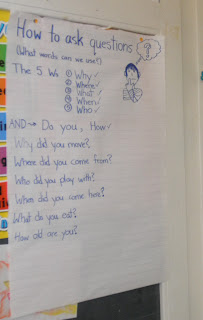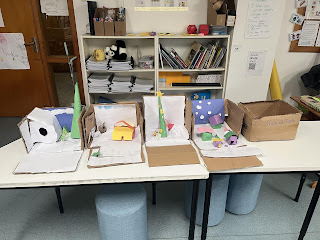Literacy - Questioning Strategies - Grade 1
From a young age, children must learn how to ask questions, in order to be inquisitive learners. As a part of the unit for Don't Need Friends by Carolyn Crimi, I taught a posing questions class to my grade one students. By using the strategy of "teacher in role" (and being enthusiastic while acting in the role), students responded curiously, wanting to ask many different questions. For students who struggled with arriving at a question on their own, they could use the questions on the brainstorm to guide them. Students asked several questions that were not originally on the brainstormed questions list, curious about the character 'Dog'. Several children wanted to tell 'Dog' what happens in the story, and had to be reminded that they were interacting with Dog before he became friends with Rat. Students respond to the power of enthusiasm, and ideally want to have fun and learn. As a result, this artifact adheres to the objective of Commitment to Students and Student Learning. This lesson connects to student experiences, ignited student curiosity and used a range of different teaching methods for the purposes of instruction and learning.
The lesson plan is under the text cut, and the consolidating activity allowed children to draw a comic of themselves asking a question, and dog responding.
Overall and Specific Expectations
Oral communication – 1. Listen in order to understand and respond appropriately in a variety of situations and for a variety of purposes
1.2 demonstrate an understanding of appropriate listening behaviour by using active listening strategies
1.3 identify listening comprehension strategies and use them before, during and after listening
2. Use speaking skills and strategies appropriately to communicate with different audiences for a variety of purposes
2.3 communicate ideas and information orally in a clear, coherent manner
Critical Consciousness
Students learn empathy for a person who is lonely and has just moved.
Enduring Understanding/Big Idea
Students learn practice empathy and question asking.
Materials
graph paper, marker, comic paper
Minds on
Tell students that today the teacher will pretend to be dog, and that students will ask dog a question, and that questions are essential to carry on a conversation, but first they need to learn some question asking words, what are some words you can start your question with? Start by brainstorming some different question words, illicit response if necessary. Explain about the five ‘W’s.
Teach the song,
“If you want to ask a question what are some words that you can use” x 2
“and how”
Students will sing this song a few times, vary the different ways it is sung. There is no mp3/CD version, it's just a short song I made up. click here to download the question song (vocals only)
Action
Students will brainstorm different questions that they can ask to dog. What do they want to know about dog? They should think of some questions that start with who, what, where, when, why and how. Make sure there is at least one of each, and write them on a piece of graph paper.
Students will then make a circle. The teacher will then assume a space in the circle, and be ‘dog’. The teacher will remind students to listen carefully to each other and not repeat any questions. She will remind them that they are asking questions to dog after he has moved. Students can ask dog a question using the questions they thought of, or one of the questions the class thought of previously. Students must put up their hand if they want to ask a question. Tell students that maybe they want to think of dog’s answers and make up questions based on dogs answers.
Reflect/Consolidate
Students will be told that they are to write a comic, containing themselves asking a question to dog. Dog must answer the question, using a full sentence. Students can think about what the teacher said as dog, or think about what they think dog would say. Students are advised to be aware that their text must fit inside the speech bubble. The teacher will draw an example comic, using a question from the chart and write the answer by modelling sounding it out. Students will be given a piece of paper and told to go back to their desks. The teacher will then erase what she wrote, so students don’t copy it. The question asking sheet will be moved up to the front.
The lesson plan is under the text cut, and the consolidating activity allowed children to draw a comic of themselves asking a question, and dog responding.
Overall and Specific Expectations
Oral communication – 1. Listen in order to understand and respond appropriately in a variety of situations and for a variety of purposes
1.2 demonstrate an understanding of appropriate listening behaviour by using active listening strategies
1.3 identify listening comprehension strategies and use them before, during and after listening
2. Use speaking skills and strategies appropriately to communicate with different audiences for a variety of purposes
2.3 communicate ideas and information orally in a clear, coherent manner
Critical Consciousness
Students learn empathy for a person who is lonely and has just moved.
Enduring Understanding/Big Idea
Students learn practice empathy and question asking.
Materials
graph paper, marker, comic paper
Minds on
Reread the story to the page where dog first moves in and is lonely. Then tell students the story of how you moved in grade 8, and were so lonely. Ask students “How is dog feeling? Have you ever moved so far you had to attend a different school? How would you feel if you moved?”
“and how”
Students will sing this song a few times, vary the different ways it is sung. There is no mp3/CD version, it's just a short song I made up. click here to download the question song (vocals only)
Action
Students will brainstorm different questions that they can ask to dog. What do they want to know about dog? They should think of some questions that start with who, what, where, when, why and how. Make sure there is at least one of each, and write them on a piece of graph paper.
Tell students to think about how dog’s face looks, and how his body is moving. Students will ask questions to the teacher, who is in the character role of "Dog".
Reflect/Consolidate
Students will be told that they are to write a comic, containing themselves asking a question to dog. Dog must answer the question, using a full sentence. Students can think about what the teacher said as dog, or think about what they think dog would say. Students are advised to be aware that their text must fit inside the speech bubble. The teacher will draw an example comic, using a question from the chart and write the answer by modelling sounding it out. Students will be given a piece of paper and told to go back to their desks. The teacher will then erase what she wrote, so students don’t copy it. The question asking sheet will be moved up to the front.







Comments
Post a Comment